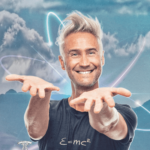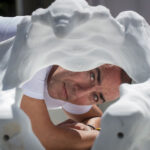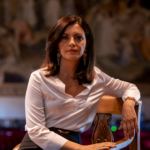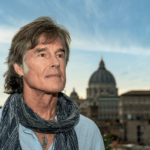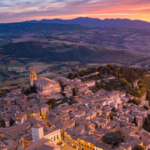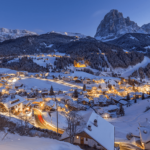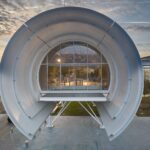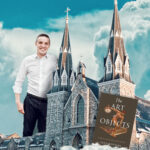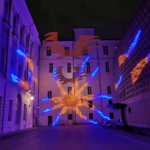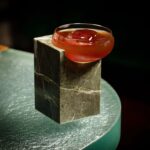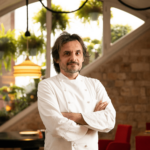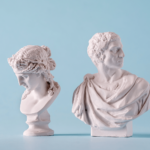Born in Como and raised in the heart of Puglia, Schettini’s early years were shaped by the contrast between these two regions and the enduring legacy of labor-driven migration that his own parents had experienced.
From an early age, it became evident that Schettini was destined for artistic expression. Growing up under the influence of an artist and art professor mother, he was immersed in a world of creativity and imagination. Encouraged by his mother and teachers, he embarked on a journey into the realm of music, beginning with a fateful encounter with the violin. Enrolling in an experimental course, Schettini quickly developed a profound affinity for the instrument, ultimately leading him to pursue formal education at the conservatory in Monopoli, where he would graduate in violin and music education.
While still in the throes of adolescence, his passion for music blossomed into the creation of the renowned gospel group, Wanted Chorus, a beloved fixture in the musical landscape of Apulia. Overtime, Vincenzo’s fascination with the intersection of science and art burgeoned, fueled in part by the awe-inspiring cinematic masterpieces of the era, including “Aliens,” “Back to the Future,” “Blade Runner,” and “Terminator.” These iconic films ignited a curiosity within him, sparking a deepseated interest in the wonders of science and its potential to unlock new frontiers of creativity.
Moreover, the transformative power of science became intertwined with his artistic pursuits, as he sought to bridge the gap between these seemingly disparate domains. It was this convergence of disciplines that would come to define Schettini’s unique approach to his craft, transcending conventional boundaries and giving rise to a body of work that resonates with depth and originality.
In 2022, he published his first book, “ La Fisica Che Ci Piace” (The Physics We Like), published by Mondadori Electa, with more than 100,000 copies sold, the publication reached the top ten of the best-selling non-fiction books in Italy that same year. In 2023, this achievement led him to win the prestigious Elsa Morante Ragazzi Esperienze award.
One year later, Schettini’s second book, “Ci Vuole Un Fisico Bestiale” (It Takes a Beastly Physicist), was released. It’s a captivating journey for both young and old, in which he recounts his daring life and highlights the physics of seven “influential” physicists from, Einstein to Fermi, who, with their discoveries (and controversies) have revolutionized the world. Schettini’s remarkable talent for elucidating intricate subject matter in an engaging and accessible manner has garnered widespread acclaim from the scientific community. Giorgio Parisi, Nobel Prize winner in Physics (2021), expressed in the preface of the book Ci Vuole Un Fisico Bestiale: “Often, scientists who discover very interesting things can be dull. Effective communication is an art that can be cultivated through dedication, inventiveness, and imagination. From this perspective, this book stands as a highly successful endeavor.”

Q&A
With creativity, charisma, and intellect, enigmatic physicist, bestselling author, and influential figure Vincenzo Schettini has orchestrated a dazzling symphony that resonates with students of all ages and the very fabric of the universe.
G.B: How was life growing-up?
V.S: I was a fragile guy when I was very young, and now the situation is even worse than in the past because of the loneliness epidemic. I felt lonely when I was young, but my parents and grandparents helped me a lot. Back then, there was no Internet, so I was connected with my parents all day, which wasn’t always good, but today they are alone on the Internet. There is a kind of desperate need to be loved, by parents, teachers, and other friends. However, there are only a few people who are recognizing that need. Students need to feel seen and heard.
G.B: Can you think of a moment in your childhood when you felt seen by a teacher and how that changed your perspective?
V.S: I started to play the violin when I was 12, even though there was no family member playing music. When I used to mention this to my friends, teachers, and so on, they would say, “This is not possible because you are so good at music, you must have a musician in your family.” And I would respond, “Oh no, I don’t.” It was because of two different things: first, I loved playing the violin, and second, my teachers loved me and encouraged me to play.

G.B: What specific strategies or tools have you found most effective in adapting to the new digital environment and connecting with students in a way that resonates with them?
V.S: First of all I love that I’m able to connect to the students even though I’m a boomer. The thing is that students will listen to a teacher (of any age) as long as the teachers are able to adapt to the new tools around us, to connect with them, because the rules have changed. For instance, if a student wants to find information, they go on the web. They go on social media. And that’s when they find me. I was there. I was there with them. And they appreciated that because I presented physics in a way they could understand. I realized that the Internet was my environment, not knowing this was the future for all of humanity.
How do objects move and interact with each other? What are the fundamental forces that shape the behavior of particles and matter? What are the basic building blocks of the universe, and how do they come together to form the world we observe? These inquiries lead to a deeper exploration of the nature of space, time, and the fundamental laws that govern the physical world.
G.B: How can an understanding of the fundamental laws of physics positively impact and guide our daily lives?
V.S: It’s important to understand that water will boil whether you add salt before or after…(laughs). Seriously, though, I believe that being aware of what is happening around us and applying it to daily life. Take, for example, sports, dancing, and even driving a car during a race, each is enhanced when you understand the laws of physics and dynamics. Understanding momentum when turning as a dancer, for instance, can improve your performance. This understanding is not only important for your training, but also because it gives you insight into what is happening. Practically speaking, last summer, I discussed the negative impact of sunbathing while under an umbrella. When under the umbrella, you are not fully protected from the sun because the sun’s rays reflect off the sand and rocks, eventually reaching you and causing sunburn. This is striking because when I apply the laws of physics to daily situations, people are impressed and become more aware. This is incredible because it allows me to realize that people are interested in physics. People enjoy science when it is tangible and something that can be applied in daily life.
G.B: What is your favorite physics experiment, one that never fails to captivate and inspire students of all ages?
V.S: Perhaps the simplest and most exciting experiment involves inflating a balloon, rubbing it on your hair, and then holding it near an empty Coke can, causing the can to start moving, which is incredible. This is very important to me because it allows me to explain to students of all ages that we are made of particles, such as electrons and protons, and that electrons have the ability to attract protons, resulting in the movement they see before their eyes. I also explain to them that the entire universe is composed of just electrons, protons, and neutrons. When I speak to students, I often share that protons and neutrons are made of quarks called “up” and “down,” and this concept is incredible for everyone, including parents.
“People enjoy science when it is tangible, and can be applied in daily life.”
After captivating audiences with sold-out talks in arenas throughout Italy, Schettini is redefining the boundaries of Art and Science with his nationwide “La Lezione Show” tour. The groundbreaking show that fuses arts and science, produced, directed and co-written by celebrated Actor, Director and Television Host Paolo Ruffini, is an immersive experience with mesmerizing demonstrations that illustrate the interconnectedness of physics and art—in a way the audience of all ages do not expect.


G.B: Who, in the world of entertainment, has inspired your artistic expression of physics—making a difficult study an entertaining one?
V.S: David Lynch is definitely my inspiration (but not only with hair). It hit me when I started watching Twin Peaks for the first time. That was incredible for me. It opened my mind. And then, I heard Lynch in an interview saying something I’ll never forget. He said something to the effect of, “It’s important as a Director to open your eyes and to describe the environment around you by using very few things. What’s important is the narrative behind that instrument that you’re using.” That was incredible for me, and that is what the “Lezione Show” is all about.
Sign up for the LF Italy newsletter
Access The Rare and Wonderful, LF Italy’s monthly newsletter. Get our latest interviews and discoveries in wellness, travel, innovation, food & drink, unique stays and more.
G.B: Can you share insights into CERN’s latest developments and innovations that we should be excited about?
V.S: Firstly, the developments of dark matter and energy, because theoretical physics has been discussed for more than 50 years, and scientists are looking for that particle related to dark matter, and they haven’t found it yet. This is going to be exciting because it represents the future of particle physics in particular. In relation to dark energy, there is something related to the concept of empty space. We are used to thinking about empty space as something empty, but this is not true. Physics is beginning to consider empty space as something which is not truly empty, and this is related to dark energy. It’s challenging. There is no such thing on the table right now, experimentally speaking, but there is a lot of excitement after the Higgs Boson discovery. Now, it’s time to move on and introduce the next discovery.

Photo @CERN
Since October 2016, Schettini has been collaborating with CERN, in Geneva, as part of the CERN ITP (CERN Italian Teacher Programmes). This program aims to promote the updating of teachers to encourage the teaching of contemporary physics in high schools and to increase the exchange of knowledge and experiences between teachers and researchers. The courses include a series of lectures given by CERN researchers and are complemented by visits to experimental installations in the laboratories of the world’s largest research center for high-energy physics. Beyond the academic value, Schettini was struck by the immense storytelling potential of modern physics to change perspectives on teaching particle physics and other energies.
G.B: You arrive at CERN for the first time—What struck you the most?
V.S: I didn’t expect to see so many young people working on hundreds of different experiments and projects. I was mesmerized and shocked to see so many hands-on situations. That’s science! Because science is not perfect. It’s about building things and working around things. Creating as you go— creating to discover. Even the environment was a surprise for me, because when you go to a place that is known around the world, you think of it as something fashionable and symmetric. But that wasn’t the first impression, because as I looked around, I saw a lot of different facilities where people were conducting experiments and working. It’s very similar to a car manufacturing plant. That’s what it looked like.
G.B: What do you find particularly mesmerizing?
V.S: The study of nuclei! Because at the end of the day, there is no end. There is no ultimate particle. If we consider the smallest elementary particle, the electron, until 20 years ago, physics claimed that it was the ultimate particle and it was not possible to go inside the electron. However, now physicists are discussing strings that are inside the electrons, vibrating. The vibrations of these strings determine the identity of the particle. When I think about the strings, my mind also wanders to ideas about music. I envision an orchestra playing something. When the orchestra plays music, that’s a particle. When the orchestra plays something else, that’s another particle. We know that many particles in the universe decay very rapidly. I could continue discussing the tiny universe and the particles in the vast cosmos, the galaxies, and the multiverse, and I wouldn’t be able to stop because I am curious, and curiosity is the ultimate sense of fulfillment that a human being can experience. I want to share this excitement of mine with people, especially with students, because this is the key to encouraging students to keep pushing forward.
G.B: How did your experience at CERN change you?
V.S: The thing is, being at CERN in Switzerland – I was surrounded by a lot of people speaking English all the time, but I felt so disconnected and I needed to do something about it. So, I came back home, opened the Internet, and went on YouTube. I started looking at things, just as my students do every day. Because the thing is, I started learning English the moment that I felt that I was not complete as a human being, not just as a teacher. I wanted to change, and I started to change.
G.B: Would you say discomfort is a vital element for change to occur?
V.S: If you feel uncomfortable, that’s the perfect step to change yourself. As far as English is concerned, but in general in life. But being uncomfortable is not enough to change yourself; you have to want that. You have to want your own change, you have to envision yourself differently.
“When I think about strings, my mind also wanders to ideas about music. I envision an orchestra playing something. When an orchestra plays music , that’s a particle. When the orchestra plays something else that’s another particle.”
— Vincenzo Schettini
G.B: Why is curiosity so important in science and life?
V.S: If you’re curious, you can change your perspective, you can change your vision about what you’re going to do in the next year, the next two years, and you can even change your life if you are able to focus on something different starting from your age, starting from you. Being curious is the first key to learning, especially at school. As for my personality, I was curious, as I mentioned before, and I started to learn a lot of things around me. I was interested in filming movies when I was very young. I was obsessed with my friends to take cameras and things and tripods, and to create a set to imitate a movie.
“Never lose a holy curiosity.”
— Albert Einstein
G.B: What is the one question that you want to leave the person reading/watching this interview?
V.S: Are you aware of the power of curiosity? Curiosity can stir everything inside of you. As a soccer team used to say, “knowledge is what we did,” so we have to put everything out of us and see the world around us. So, if you become aware of the power of curiosity, you can live your life, be happy, and relate to all the people around you. You can even find happiness, as happiness is something that does exist. When we are not aware of the power of life, the power of knowledge, and the power of curiosity, we miss out.

Credit: Photos by Giovanni Albore / La Fisica Che Ci Piace




